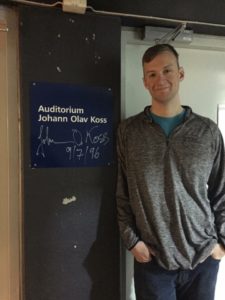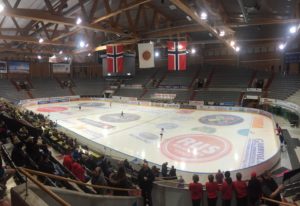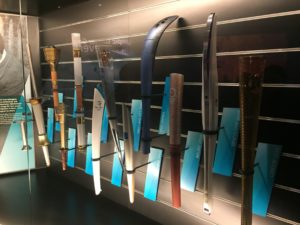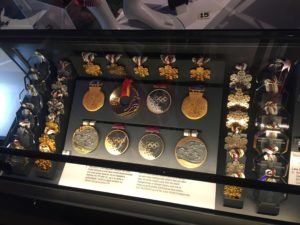Along with Dr. Banks wearing only a t-shirt in freezing weather, early alarms and long travel days are the norm on this journey. Today was no exception. The group was awake, fed, and ready to load the bus by 7:45 this morning. This marks the first time we will be traveling via bus for an extended period as we make the three hour trek through Hamar to Lillehammer. There may not be any flight attendants but we do have our driver Ueka, a Finnish man with a map and a plan.
The ride began with class for those who hadn’t already fallen asleep. First Camryn and Siri spoke about the evolution of the Winter Olympics. The Olympics, both winter and summer, are incredibly influential events on a global stage, making it interesting to learn more about their roots. The first Winter Olympic Games were given that title in retrospect, as they were called the “International Winter Sports Week” at the time they were played. There has been significant growth in the Winter Games, beginning with 8 sports and now hosting 15. In 1952 the Oslo games allowed women to compete for the first time, and in 1994 Lillehammer hosted the games. Greta and Emily briefed us on the ’94 games, specifically discussing the Tonya Harding v. Nancy Kerrigan scandal. With its occurrence happening before many of us were born, several of us were unfamiliar with the scandal. In short, Harding and Kerrigan were both Americans and arguably the two largest names in women’s figure skating since Sonja Henie and Mother Theresa.
Prior to the Olympic Games, Kerrigan was attacked a few nights before she was set to earn her spot on the Olympic team at the trials in Detroit. It was reported that she was attacked by a man with a club, suffering injuries to her landing leg. An FBI investigation found Harding’s husband to have hired a hit-man for the attack. The mystery surrounds Tonya Harding’s involvement and whether she knew the attack was happening. Did Harding know? Could she have stopped it? Who killed Kennedy? We may never know.
This incident has been credited with sparking growth in figure skating’s popularity, specifically in America. It was a real life Blades of Glory without the Hollywood ending. At the time, the Harding/Kerrigan finals were one of the most watched TV events in American history and even topped Super Bowl viewership in ’94. It ranks among the 20 most watched sporting events in American television history. People love a good controversy!
The first portion of our bus ride was to Hamar, which we hammered out in about an hour. Hamar is the home of the first European and World Championships for speed skating, and our first stop was at their Olympic speed skating stadium, Vikingskipet. Speed skating is more prominent in Norway than arguably anywhere else in the world, so we were watching some of the world’s best. As they zip around the track, the racers reach speeds of up to 45 kilometers per hour. The skaters were sporting tight spandex suits of various colors, and we learned that those who were wearing red Norway suits had previously represented the national team at some level. The suits are a statement of both fashion and skating ability. There were several famous speed skaters in attendance, including former Olympic medalists. It was a special experience to be in the presence of Norwegian Olympians, both young an old.

Vikingskipet speed skating facility
A member of our group has a particularly special connection Vikingskipet and Norwegian speed skating. The second cousin of our pal Nate DeFoe was Johann Olav Koss, a gold medalist in speed skating at the ’94 Olympic Games in Lillehammer. Koss has amassed four Olympic Golds and 1 Silver in his trophy case while also breaking 10 world records throughout his career. As a result of his accomplishments the auditorium at Vikingskipet is named after Koss. Nate may not have the Olympic medals, but he has the dashing good looks that must run in the family.

Following Vikingskipet was a brief stop at the arena where the Kerrigan v. Harding ’94 Olympic figure skating finals were held. The 30 minute visit was spent watching teenage girls out on the ice jumping, spinning, and landing on their backs.

Upon arrival to Lillehammer, the group checked into the hotel and enjoyed another fantastic meal. Nothing less is to be expected at this point. This arrangement featured a local beef stew among other options. Shortly thereafter the group embarked on an * Olympic quest* to the Norwegian Olympic museum.
The museum was opened on November 27, 1997 and then renovated and reopened in 2016. It has over 7000 Olympic items and is the only museum in Northern Europe that presents the entire history of the Olympics. Some of our personal favorites were a collection of Olympic torches and a display of Olympic medals throughout history.


The contents of the museum were dominated by winter Olympic history, specifically skiing. Norway is obviously a step above the rest of the world when it comes to ski events, so they had a large exhibit to showcase their winter Olympic feats. An interactive biathlon simulator was a popular attraction as everyone took their turns skiing and shooting. It was clear that our group lacks any future biathletes, but Ethan “Sharp Shooter” Stordahl posted the best mark with 6/10 targets hit.
Like everything else in Lillehammer, the museum closed at 4. This left the rest of the evening for the O-Questers to do whatever they pleased. After a day of traveling and Olympic site visits, most of the group was tired. Everyone spent the night avoiding any physically demanding activities, focusing their energy on the excitement of dog sledding and skiing tomorrow.
Today our group was exposed to some of the popular winter sports in Norway. Today has been our largest exposure to Olympic sport thus far. A large part of this trip is learning about cultures different than our own, and sport is a major part of culture. We were fortunate today to be able to visit some prominent Olympic venues to watch sports that are extremely popular throughout Norway. Even if these sports don’t interest you as an individual, it is valuable to be exposed to them in order to have a well-rounded experience in the Nordic countries.
Ha det bra! (Take Care)
Connor Kern & Dalton Mattson